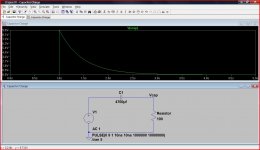Apologies Mooly, I am missing something here, are you referring to the schematic for 1984 design?? then I am following it entirely...I just picked the Zobel before output cap from that design, for the entirety I am using this schematic

Sent from my iPhone using Tapatalk Pro

Sent from my iPhone using Tapatalk Pro
Yes, I was always working to the original design which is what you are showing now, and I thought you were modifying the original with those extra 1nf caps you showed in the other diagram.
I'll look in again tomorrow and see how you are getting on 🙂
I'll look in again tomorrow and see how you are getting on 🙂
Relief...cheers...good night, pretty late for me in India
Sent from my iPhone using Tapatalk Pro
Sent from my iPhone using Tapatalk Pro
The only 'official' update to the JLH that I know of is the September 1996 version that was described in Electronics World magazine.
Results post night

After shorting the output

After 45 mins

I am worried the first start would damage my speakers if I don't resolve this
[emoji19]
Sent from my iPhone using Tapatalk Pro

After shorting the output

After 45 mins

I am worried the first start would damage my speakers if I don't resolve this
[emoji19]
Sent from my iPhone using Tapatalk Pro
Its absolutely normal.
Prove it to yourself 🙂
Take a discharged electrolytic cap of 1000uf or more and connect just the positive terminal to your +19 volt rail. Now measure the voltage on the floating negative end of the cap. It will be around +19 volts.
Prove it to yourself 🙂
Take a discharged electrolytic cap of 1000uf or more and connect just the positive terminal to your +19 volt rail. Now measure the voltage on the floating negative end of the cap. It will be around +19 volts.
This shows a 4700uf with 9 volts applied. We are measuring the voltage at the end of the cap by using a meter as a load and then by using a 100 ohm as a load.
Look at the time scale at the bottom. 20ks and 40ks are 20,000 seconds, 40,000 seconds and so on. It would take that long for the voltage to fall to zero... and in practice it never would because a real cap is a bit leaky.
Now look at the 100 ohm and how quickly that comes to zero volts. Your speaker will be much quicker still.
So all normal.
Look at the time scale at the bottom. 20ks and 40ks are 20,000 seconds, 40,000 seconds and so on. It would take that long for the voltage to fall to zero... and in practice it never would because a real cap is a bit leaky.
Now look at the 100 ohm and how quickly that comes to zero volts. Your speaker will be much quicker still.
So all normal.
Attachments
If you choose to disconnect the speaker for the switch on transient, then you must provide a path (current route) for the charging current into the capacitor.
Else when you connect the speaker/headphone that pulse is applied instantly the new connection is made.
Else when you connect the speaker/headphone that pulse is applied instantly the new connection is made.
Last edited:
What is this software you using for simulation
Sent from my iPhone using Tapatalk Pro
Click my signature line. It will tell you all you need to know to get started.
Ok, but is not happening with other amps...e.g. Amp Camp Amp, maybe will try get hold of this software and try sim for that circuit..meanwhile for ref the aca circuit..

Sent from my iPhone using Tapatalk Pro

Sent from my iPhone using Tapatalk Pro
The ACA uses 3300uf and has a 1k to ground. So when you power it up the cap charges really quickly through the 1k and you see no voltage.
LTspice is here:
Linear Technology - Design Simulation and Device Models
If you want LT-IV then select the 'Download LTspice for Windows XP' option. That will run on any Windows OS.
The top one is for W7 and above only and is now LTspice XVII but its very similar.
LTspice is here:
Linear Technology - Design Simulation and Device Models
If you want LT-IV then select the 'Download LTspice for Windows XP' option. That will run on any Windows OS.
The top one is for W7 and above only and is now LTspice XVII but its very similar.
Humm, shud try and replicate a 1K resistor for JLH.....
Sent from my iPhone using Tapatalk Pro
Sent from my iPhone using Tapatalk Pro
It would be good practice.
If you switch the JLH on with no speakers attached and then connect the speakers then you will get a big thump as the cap charges quickly into your speaker.
If you fit a 1k then the cap charges after a few seconds and so you would get no noise connecting the speaker.
If you always leave the speakers connected to the amp then the 1k makes no difference.
If you switch the JLH on with no speakers attached and then connect the speakers then you will get a big thump as the cap charges quickly into your speaker.
If you fit a 1k then the cap charges after a few seconds and so you would get no noise connecting the speaker.
If you always leave the speakers connected to the amp then the 1k makes no difference.
- Home
- Amplifiers
- Solid State
- JLH 10 Watt class A amplifier


